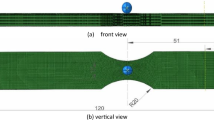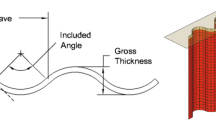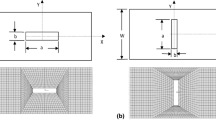Abstract
The prediction of ultimate strength remains the main challenge in the simulation of the mechanical response of composite structures. This paper examines continuum damage model to predict the strength and size effects for deformation and failure response of polymer composite laminates when subjected to complex state of stress. The paper also considers how the overall results of the exercise can be applied in design applications. The continuum damage model is described and the resulting prediction of size effects are compared against the standard benchmark solutions. The stress analysis for strength prediction of rotary wing aircraft cabin door is carried out. The goal of this study is to extend the proposed continuum damage model such that it can be accurately predict the failure around stress concentration regions. The finite element-based continuum damage mechanics model can be applied to the structures and components of arbitrary configurations where analytical solutions could not be developed.











Similar content being viewed by others

References
Hinton M.J., Soden P.D.: Predicting failure in composite laminates: the background to the exercise. Compos. Sci. Technol. 58, 1001–1010 (1998)
Maimí P., Camanho P.P., Mayugo J.A., Dávila C.G.: A continuum damage model for composite laminates: part I - constitutive model. Mech. Mater. 39, 897–908 (2007)
Maimí P., Camanho P.P., Mayugo J.A., Dávila C.G.: A continuum damage model for composite laminates: part II - computational implementation and validation. Mech. Mater. 39, 909–919 (2007)
Camanho P.P., Turon A., Costa J., Dávila C.G.: A damage model for the simulation of delamination in advanced composites under variable-mode loading. Mech. Mater. 38(11), 1072–1089 (2006)
Dvorak G.J., Laws N.: Analysis of first ply failure in composite laminates. Eng. Fract. Mech. 25, 763–770 (1986)
Camanho P.P., Da’vila C.G., Pinho S.T., Iannucci L., Robinson P.: Prediction of in situ strengths and matrix cracking in composites under transverse tension and in-plane shear. Compos. Part A. 37, 165–176 (2006)
Parvizi A., Garrett K., Bailey J.: Constrained cracking in glass fibre reinforced epoxy cross-ply laminates. J. Mater. Sci. 13, 195–201 (1978)
Standard test methods for mode I inter-laminar fracture toughness of unidirectional fiber-reinforced polymer matrix composites, ASTM D5528–01. West Conshohocken (PA), USA: American Society for Testing and Materials (ASTM)
Martin R, Elms T, Bowron S., : Characterization of mode II delamination using the 4ENF, Proceedings of the 4th European conference on composites: testing and standardization, Lisbon (1998)
Lopes C.S., Camanho P.P., Gürdal Z., Maimi P., Gonzalez E.V.: Low-velocity impact damage on dispersed stacking sequence laminates. Part II: numerical simulations. Compos. Sci. Technol. 69, 937–947 (2009)
Overgaard L.C.T., Lund E., Camanho P.P.: A methodology for the structural analysis of composite wind turbine blades under geometric and material induced instabilities. Comput. Struct. 88, 1092–1109 (2010)
Mabson, G., Lyle, R.D., Dopker, B., Hoyt, D.M., Baylor, J.S., and Graesser, D.L., : Fracture Interface Elements for Static and Fatigue Analysis, 16th International Conference on Composite Materials, Kyoto, Japan (2007)
van der Meer F.P., Sluys L.J.: Continuum models for the analysis of progressive failure in composite laminates. J. Compos. Mater. 40, 2131–2156 (2009)
van der Meer F.P., Oliver C., Sluys L.J.: Computational analysis of progressive failure in a notched laminate including shear nonlinearity and fiber failure. Compos. Sci. Technol. 70(4), 692–700 (2010)
Iarve E.V., Mollenhauer D., Kim R.: Theoretical and experimental investigation of stress redistribution in open hole composite laminates due to damage accumulation. Compos. A: Appl. Sci. Manuf. 36, 163–171 (2005)
Maimı´ P, Camanho PP, Mayugo JA, Da’vila CG. : A thermodynamically consistent damage model for advanced composites. NASA Technical Memorandum 214282, National Aeronautics and Space Administration (2006)
Joffe R., Krasnikovs A., Varna J.: COD-based simulation of transverse cracking and stiffness reduction in (S/90n)s laminates. Compos. Sci. Technol. 61, 637–656 (2001)
Hashin Z.: Failure criteria for unidirectional fiber composites. J. Appl. Mech. 47, 329–334 (1980)
Catalanotti G., Camanho P.P., Xavier J., Dávila C.G., Marques A.T.: Measurement of resistance curves in the longitudinal failure of composites using digital image correlation. Compos. Sci. Technol. 70, 1986–1993 (2010)
Camanho P.P., Maimí P., Dávila C.G.: Prediction of size effects in notched laminates using continuum damage mechanics. Compos. Sci. Technol. 67(13), 2715–2727 (2007)
Wisnom M.R.: Size effects in the testing of fibre-reinforced composites. Compos. Sci. Technol. 59, 1937–1957 (1999)
Bazˇant Z.P., Zhou Y., Nova’k D., Daniel I.M.: Size effect on flexural strength of fiber-composite laminates. J. Eng. Mater. Technol. 126, 29–37 (2004)
Bazˇant Z.P.: Size effect. Int. J. Solids Struct. 37, 69–80 (2000)
Parvizi A., Garrett K., Bailey J.: Constrained cracking in glass fibre reinforced epoxy cross-ply laminates. J. Mater. Sci. 13, 195–201 (1978)
Waddoups M.E., Eisenmann J.R., Kaminski B.E.: Macroscopic fracture mechanics of advanced composite materials. J. Compos. Mater. 5, 446–454 (1971)
Pinho, ST. Modelling failure of laminated composites using physically-based failure models, PhD thesis. Department of Aeronautics, Imperial College London, UK, 2005
Pinho S.T., Robinson P., Iannucci L.: Fracture toughness of the tensile and compressive fibre failure modes in laminated composites. Compos. Sci. Technol. 66, 2069–2079 (2006)
Gangadhara Rao T Boyina, R. Vijaya Kumar, V.V. Subbarao., Damage Assesment of Rotary Wing Aircraft Cabin Door using Continuum Damage Mechanics Model, Proceedings of 72nd American Helicopter Society and Exhibition, West Palm Beach, Florida, USA, 2016
ANSYS User Manual, Release 17.0, ANSYS Inc.
Author information
Authors and Affiliations
Corresponding author
Rights and permissions
About this article
Cite this article
Boyina, G.R.T., Rayavarapu, V.K. & V. V., S.R. Numerical Modelling and Damage Assessment of Rotary Wing Aircraft Cabin Door Using Continuum Damage Mechanics Model. Appl Compos Mater 24, 235–250 (2017). https://doi.org/10.1007/s10443-016-9524-1
Received:
Accepted:
Published:
Issue Date:
DOI: https://doi.org/10.1007/s10443-016-9524-1



